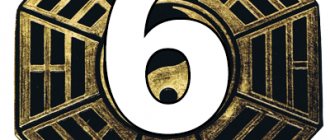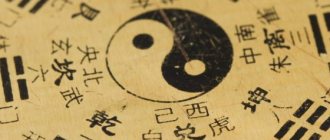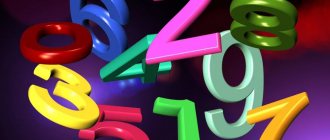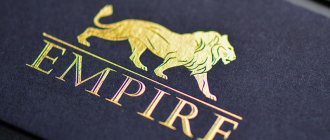Today you also have a chance to positively influence your destiny and attract real luck in all matters. The secret lies in the unique properties of the imperial size .
Imperial sizes are measured with a special ruler of 43.2 cm, divided into eight parts, each of which carries certain information, and is also subdivided into four more parts.
Why do you need to consider imperial sizes?
As you remember, the teaching of Feng Shui is based on the interaction of a person with the surrounding space. All objects around you have not only a shape, but also a certain size. If you make sure that these dimensions are favorable, you can change your whole life for the better. You don't have to take into account every detail, just focus on reconstructing what is of great importance to you or what you use often.
Before we move on to the examples, consider the meanings of Imperial sizes:
Translation of segment names
It is noteworthy that on the back of the ruler there is a different version of the Feng Shui lines drawn. The divisions in the second version of the Feng Shui foot are slightly smaller than in the first, but still larger than in the standard Chinese foot by 2.8 Chinese inches. I was amazed to find out that this is exactly the long side of this special feng shui tool!
Moreover, this Chinese foot is divided into 10 sections with additional names that correspond or are similar to the names on the face of the ruler. Based on this, it can be seen that the 10 segments are arranged in reverse order, although it is obvious that this was done simply for convenience, and not for mystical reasons.
As on the obverse, the 10 divisions are divided into smaller segments, each of which has its own name (“Divine Virtue” or “Mouth and Tongue”), coinciding with the names of the stars that are used in Chinese astrology and calculations of other divination systems.
When measuring rooms and other large spaces, carpenters, masons and practicing Feng Shui enthusiasts began to use measuring tapes with similar divisions.
They are marked with several feet of Feng Shui, identical in length and divisions to the segments on the wooden Ding Lan ruler. Ding Lan ribbons show two types of measurements, each on one of the edges of the ribbon, and, unlike a wooden instrument, they are placed in the same direction.
How to use imperial sizes?
First of all, calculate the size of those things that you often use, for example, a wallet, bag, notebook and even a wish notebook (imperial size can have a very beneficial effect on the fulfillment of your plans).
Look what you got. Let's say your notebook is 40x30 cm. Based on the values, we find that 40 brings good luck in exams, and 30 portends shame. Correct the situation!
If you cannot cut off the “extra” centimeters, then take a piece of red fabric, adhesive tape or plain paper and stick it on your notebook so that it turns out not 30, but, for example, 25 cm (promising income). The red color “burns” the excess area, and, as it were, excludes it from the overall dimensions. By the way, you can also use a red marker, pencil, etc.
Or “grow” the desired piece. You can take a ribbon, as well as a piece of paper (just not red!), a keychain or something else, and carefully attach it to the edge. This is how you will adjust your item to favorable sizes.
LiveInternetLiveInternet
Quote from Juliana-Juliana's message
Read in full In your quotation book or community!
Feng Shui ruler. Feng Shui: calculation program.
Favorable sizes are given great importance in Feng Shui. There is a unique tool for creating ideal proportions according to Feng Shui. This is the so-called Feng Shui line. It is believed that these dimensions were discovered by a carpenter at the imperial palace of the Sunn dynasty. And it is still used by craftsmen to measure pieces of furniture, windows, doors, etc. It consists of four “favorable” and four “unfavorable” main segments. In translation, the names of these segments mean different cycles. Inside these cycles there are four more small segments. The entire full cycle of the ruler corresponds to 43.18 cm. The full cycle of the ruler is repeated ad infinitum. 1. Zhai - Cycle of luck (wealth and abundance) From 0.00 to 1.35 cm - luck in money From 1.35 to 2.70 cm - security and prosperity, a filled precious safe From 2.70 to 4.05 cm - six at once types of luck From 4.05 to 5.40 cm - happiness and abundance 2. Pi - Disease cycle (prison or death) From 5.40 to 6.75 cm - monetary losses, decreased income From 6.75 to 8.10 cm - probability of occurrence problems with the law and authorities, possible legal problems From 8.10 to 9.45 cm - portends trouble, including imprisonment From 9.45 to 10.8 cm - premature death of one of the spouses 3. Lee - Cycle of separation (loss and robberies) From 10.8 to 12.14 cm - “a container of failures”, a lot of bad luck From 12.14 to 13.49 cm - loss of money From 13.49 to 14.84 cm - meeting with dishonest people who will try to deceive you From 14.84 to 16.19 cm - probability of theft or robbery 4.I - Mentor cycle (ceremony, good luck in communication, business connections and children's luck) From 16.19 to 17.54 cm - good luck in the offspring, wonderful luck for children From 17 .54 to 18.89 cm - additional income from unexpected sources From 18.89 to 20.24 cm - probability of success for sons From 20.24 to 21.59 cm - significant success in all endeavors, excellent luck 5. Quan - Official Cycle (cycle power, advancement) From 21.59 to 22.94 cm - success in studies and successful passing of exams From 22.94 to 24.29 cm - good luck in gambling, lotteries and speculation, luck in trading From 24.29 to 25.64 cm - increase in income, increase in income From 25.64 to 26.99 cm - prosperity, power and glory for the whole family, high honors 6. Jie - Cutting cycle (robbery, loss of money) From 26.99 to 28.34 cm - brings death or separation , departure From 28.34 to 29.69 cm - deprivation of livelihood, loss of important things From 29.69 to 31.04 cm - the likelihood of being shamefully expelled from their usual environment From 31.04 to 32.39 cm - brings ruin, heavy financial losses 7. High - Cycle of accidents (damage, quarrels) From 32.39 to 33.73 cm - brings impending disasters From 33.73 to 35.08 cm - indicates death From 35.08 to 36.43 cm - brings various serious illnesses From 36.43 to 37.78 cm - scandals and quarrels 8. Pan - Cycle of happiness (prosperity) From 37.78 to 39.13 cm - brings a significant influx of money, good luck with money From 39.13 to 40.48 cm - good luck in exams From 40.48 to 41.86 cm - attracts precious stones to life. From 41.83 to 43.18 cm - attracts abundance, prosperity and happiness to life. Favorable segments-cycles: first, fourth, fifth and eighth. Unfavorable segments-cycles: second, third, sixth and seventh. Let's consider the use of favorable sizes using the example of a desktop. We take into account the length, width and height of the table. For example, the desk of a company executive should be 84cm high, 109cm wide and 195cm long. The manager's desk should be 84cm high, 86cm wide and 152cm long. The secretary's desk should be 81cm or 84cm high, 84cm or 66cm wide and 147cm long. These are extremely favorable sizes for desks and will contribute to prosperity and success at all levels of the company. In addition to making furniture and windows immediately to favorable sizes, there are several ways to correct existing ones. For example, if the windows have unfavorable dimensions, then we can “bring them” to favorable sizes by gluing an opaque film to the edge of the glass. If the front door has unfavorable dimensions, then the part of the door painted red will be considered “burnt”, i.e. non-existent, and thus the door will take the favorable size we need. Thus, by using favorable sizes of furniture, doors or windows, we bring positive energies into our lives and eliminate negative ones. author Eremina Olga source https://masterskaya-feng-shui.com/linejka-fen-shuj/ Feng Shui: calculation program. This program consists of “Personal Feng Shui” and “Spatial Feng Shui”. You can download it for free from this site https://allsoftlab.com/main/education-and-science/d...shuj-programma-raschyotov.html
Amulets to attract money
When you have bought a new storage for money, we begin to fill it. Don’t rush to put bills in it right away. First, amulets take their place in the wallet, which are designed to attract money. These could be Chinese coins with holes, the American dollar, oriental symbolic designs and runes.
You can also put Russian amulets. It's good to keep beans, cinnamon and horseradish in your wallet. Bob is designed to save money, cinnamon attracts with its aroma, horseradish collects material energies. Horseradish cannot be bought at the market. You need to dig it up yourself and dry it thoroughly. Only then will he have the strength given by nature. You can also put our native Russian ruble. Before this coin goes into your wallet, never to leave it again, it must be cleaned, that is, kept in a strong saline solution for three days. The color of the coin will change due to the action of salt, but it will get rid of the negative energy of other hands in which it has been.
Filling the wallet
When all the amulets have taken their places, we move on to the ritual of putting money in the wallet. All bills should be carefully smoothed by hand so that they become more familiar with them. The bills should be laid out in order: from large to small, always with portraits facing up. As soon as the first bill gets into your wallet, give the task to the new custodian - “Keep and multiply.” In the future, the wallet should be treated with due respect. It should never be left empty, meaning there should always be money left in it. Even just a little, for one loaf of bread or one trip on public transport, but they should stay there.
You definitely need to buy the wallet yourself. Don’t rush to put your savings in a gifted wallet, especially if it was presented to you by someone you don’t know well. This accessory is very powerful. How do you know for what purpose it was given to you? It is best to get rid of such a gift as soon as possible or simply put it on a distant shelf.
Color
Red color is very powerful, but no less finicky
According to Feng Shui experts, each person has their own “own” colors. They are determined depending on which element patronizes you. An important role is played by the elements that are adjacent to it in the circle of Destruction.
Useful information: The element can be calculated by the last digit of the year of your birth. True, you need to take into account the year according to the Eastern calendar, which differs from ours.
- 0 or 1. Element – metal, your colors – white, silver, shades of gray.
- 2 or 3. Element – water, your colors – black, violet, indigo, blue, cyan.
- 4 or 5. Element – wood, your colors – brown, shades of green.
- 6 or 7. Element – fire, your colors – burgundy, scarlet, carmine, red, pink.
- 8 or 9. Element – earth, your colors – yellow, gold, orange, beige.
There are some nuances that must be taken into account when choosing the color of your wallet. People who are under the protection of the element of metal should not choose a gray wallet. But for those who belong to the water element, it will be most difficult to find the ideal option. The fact is that all tones of blue and black are not suitable for a wallet. They are permeated with water energy, so they will simply “wash” money out of it.
You can approach this issue from the other side. The earth element is responsible for accumulation. Therefore, when choosing a wallet, you can give preference to brown, beige and yellow tones - this way you definitely won’t miss it. In such a wallet, money will accumulate much faster and stay for a longer period of time.
This is interesting: Most often in special Feng Shui stores you can find red wallets. This color is universal; it has strong energy, which is used for various purposes. For example, to activate some kind of talisman or to enhance the magical influence of symbols and objects. But you should know that red wallets are not only the most “powerful”, but also very finicky. The owner must always keep such a wallet in perfect condition; it must certainly be of high quality and stylish. The ideal material is expensive leather.
Note that scarlet, burgundy, purple and garnet shades also have powerful energy in terms of attracting money.
What to do if the object is more than 43.2 cm
The Chinese Feng Shui ruler is not limited to 43.2 cm. Measurements can be continued endlessly, repeating each size again. For ease of use, use classic rulers, measuring tapes and tape measures. The value of a particular size can be determined by simple mathematical calculations.
Example: To measure large pieces of furniture, such as a desk, use a simple 3-step formula: h/43.2 = x, where h is the length of the tabletop, and x should be rounded to the nearest whole number. 43.2 * x = y, where y is a variable value.h – y = z, where z is the desired size according to Feng Shui.
If we translate the example into numbers, then when measuring a table with a tabletop length of 150 cm, we get the following:
- 150/43.2 = 3.47, round the resulting number to 3.
- 43,2 * 3 = 129,6.
- 150 – 129,6 = 20,4.
The result obtained has a favorable interpretation and attracts success in general affairs.
If, after calculations, a number is obtained from an unfavorable interval of the ruler, then you can “deceive” the flows of energy by painting or covering the “extra” centimeters with red.
Only from natural materials
When choosing a wallet, pay attention to the material from which it is made. Following Feng Shui, choose natural foundations that will open up a free path for monetary energy. An excellent option is a wallet made of genuine leather, as well as ladies' purses made of suede and fabric.
It won’t hurt if the appearance of the accessory distracts attention from your banknotes, which means that no one will be able to take away their energy from you. At the same time, wallets made of artificial leather should be avoided, precisely because it is not a “conductor” of energy and closes the “doors” leading to your wealth.
Feng Shui proportions and the golden ratio
The answer to our riddle lies in the length of the first wooden original of the feng shui line. Its standard length, a little over 14 Chinese inches, reminded me of a number that often came up in math lessons when I was in school, namely the square root of 2, which has an approximate decimal expression of 1.4142.
It is noteworthy that just a few decades ago, this number for most people was nothing more than the result of mathematical calculations and the curiosity of Pythagoras, and as useful as the binary notation system.
In fact, just as the binary system has become the basis of all modern digital technology, that curious "irrational" number 1.4142 has its practical uses around every corner, unless you're in America!
For example, in Europe, stationery paper is measured in “A” formats: A4 is a standard sheet, A3 is double size, A5 is half this size. These formats are convenient because the page size can be halved or doubled any number of times, but the proportion - the shape of the sheet - will always be the same.
However, this is only possible because the basic dimensions of the sides of a page are “irrational” numbers that cannot be accurately expressed in decimals or fractions. Thus, if the short side of a sheet of A4 paper is X cm, then the long side will be equal to X times the square root of 2.
Chinese builders, architects and carpenters adopted this ratio of 1:1.4142 as the most aesthetically perfect. Therefore, the feng shui ruler has “feng shui feet” as its units of measurement, so that if the length of a piece of furniture or the distance in a room is, say, 3 Chinese feet, to bring the space to perfect proportions, the width of the item should be 3 feng shui feet .
ABCD is a square whose length is x. AC is a diagonal whose length is y. Since the sides AD and DC are equal, then, according to Pythagoras, the square y is the square of 2, so y is the square root of 2. AE and DF are segments equal to the diagonal y, so the sides of the rectangle AEFD are in the ratio of 1 to the square root of 2.
In rectangle AEFD, sides AD and DF are in the ratio of 1 to the square root of 2. Point L lies on the diagonal AF. And according to Apollo's theorem, triangles AKL and AEF are correlative, therefore, in the rectangle AKLM, the sides AM and ML must also be in the proportion of 1 to the square root of 2.
Since length standards in China differed from province to province (as indeed they did in Europe before the adoption of a single metric system), it is inevitable that feng shui rulers made in different places also differed.
When I realized that the feng shui ruler depicted ratios and not actual lengths, I immediately realized that this is what Euclid called the “golden ratio” and that the ancient Greeks used it in art and architecture. In my book “Feng Shui”, in the chapter on Feng Shui methods, I characterized the proportions of Feng Shui themselves, but I must admit, I was wrong because I missed the fundamental point showing the significant difference between Chinese and Western (originally ancient -Greek) aesthetic principles of architecture.
Euclid's "Golden Ratio" states that if the base AB of rectangle ABCD is divided at a specific point, X, then a square with side AX is equal in area to rectangle ABCD.
Painters of the classical school strive to create the composition of their paintings according to the “golden rectangle”, but the proportions are not the same as the sides of an A4 sheet, they are more elongated.
Thus, the dimensions of the first photographic paper corresponded to the principle of the “golden ratio”. However, they lack the refined simplicity of feng shui proportions, so when photographic paper was cut in half, the proportions were no longer as aesthetically harmonious.
For example, it is very easy to see that if you divide a rectangle 20 cm long and 10 cm wide in half, you get two squares with a side of 10 cm. And from a square divided into two parts, you get two narrow rectangles.
If you take a sheet of paper A measuring 8 cm by 13 cm and fold it in half, then the sides of the resulting rectangle B will be 6.5 cm by 8 cm. The proportions of sheet A are 128:208, while the proportions of rectangle B are 169:208, the difference is almost 20 percent! Of course, this is not the only example; a difference of 20% is obtained in any case, with different sizes.










